 Raise a Glass to Freedom
Raise a Glass to Freedom
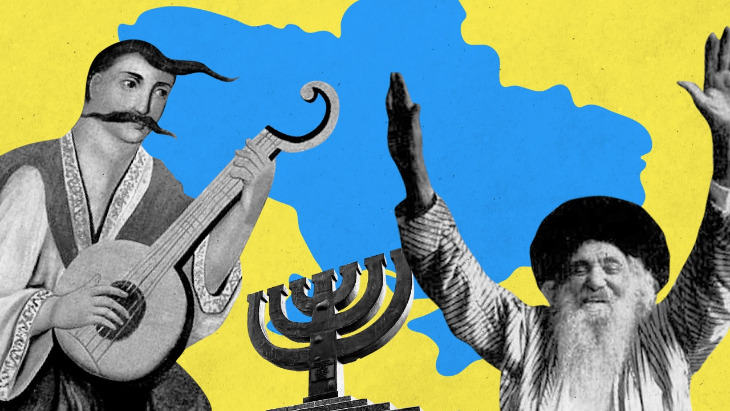

16 min read
Key moments of Jewish history have occurred in Ukraine.
With a huge build-up in Russian troops along Ukraine’s borders in recent weeks, many people are fearful that Russia will invade Ukraine. Ukraine is a complex and diverse nation with an incredibly rich Jewish history. Here are 12 facts about Jews in Ukraine.
Jews have been living in present-day Ukraine since ancient times. The ancient Greek city of Chersonesos, near present day Sevastopol (located in the Crimean Peninsula, which was formerly part of Ukraine and was annexed by Russia in 2014), was once home to Jews. Prof. J. Andrew Overman of Macalester College directed the Black Sea Project in the 1990s, and described some of his team’s many Jewish finds:
“The team has focused on uncovering evidence of a Jewish presence in Chersonesos during the Roman period. Menorahs, oil lamps with a Torah shrine depicted on the face, and graffiti in Hebrew and Greek have all been found at Chersonesos. One Hebrew fragment even mentions Jerusalem – the only known instance of this outside of ancient Israel. Additionally, one of the menorahs appears to date from the hellenistic period, making it one of the earliest known to scholars,” Prof. Overman observed in 1997 in a letter to The New York Times.
Eastern Ukraine was home to the Khazar empire, a kingdom of Turkic people that arose in southeastern Russia in the 6th Century CE and extended as far west as Kiev, the capital of present-day Ukraine. In the 8th Century, the Khazar king converted to Judaism and ordered that his followers do so as well. Many Khazars became Jewish, embracing Jewish holidays and Shabbat and keeping kosher.
 The Khazar "Moses coin" found in the Spillings Hoard and dated c. 800. It is inscribed with "Moses is the messenger of God" instead of the usual Muslim text "Muhammad is the messenger of God".
The Khazar "Moses coin" found in the Spillings Hoard and dated c. 800. It is inscribed with "Moses is the messenger of God" instead of the usual Muslim text "Muhammad is the messenger of God".
The Khazars at the time were ruled by a semi-divine king called a Khagan, and local chieftains called “Begs”. Legend says that the Khazar king ordered representatives from the three monotheistic faiths to his palace and listened to each of them discuss their religion. He was struck with Judaism’s beauty and lucidity.
In the Middle Ages, the great Spanish Jewish sage Judah Halevi (1075-1141) wrote The Kuzari, a beautiful philosophical book that imagined the discussion between the king of the Khazars and the visiting rabbi. The Kuzari is a robust defense of Judaism against critics from other religions and from indifference.
The Middle Ages were a tumultuous time in Ukraine. Accounts describe the city of Kiev as being home to a substantial Jewish community in the 11th and 12th centuries. There were two heavily Jewish suburbs of the city, and one entryway into Kiev’s city walls that was known as the “Jewish Gate”. There are also references to a Jewish scholar at the time known as Moshe ben Yaakov of Kiev.
In the early Middle Ages, the largely Jewish kingdom of the Khazars was buffeted by invading Russian forces, which ransacked its capital city in about the year 965 CE. The end of the Khazar kingdom came in the 1200s, when Mongol tribes invaded much of present-day Ukraine and Poland, causing huge devastation and loss of life. In order to build back its power and wealth, Poland invited new residents to move into its territories from the west, primarily from Germanic lands.
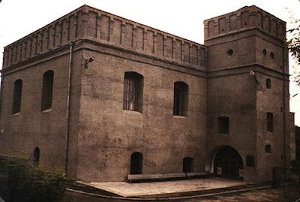 The Great Synagogue of Lutsk, renovated after WW2. Lutsk, Ukraine 1984. Beit Hatfutsot, the Oster Visual Documentation Center. Courtesy of Anna Herz, Germany
The Great Synagogue of Lutsk, renovated after WW2. Lutsk, Ukraine 1984. Beit Hatfutsot, the Oster Visual Documentation Center. Courtesy of Anna Herz, Germany
Poland’s invitation for immigrants to come attracted Jews who were fleeing massacres in central Europe in the wake of the Crusades and the Black Death. Jews settled throughout Poland, including in territories that form present-day Ukraine, most notably the region of Volhynia, which lies at the intersection of Poland, Belarus and Ukraine. By the 1400s, up to 30,000 Jews were thought to be living in 60 different communities across Ukraine, including in the present day capital city, Kiev.
Jewish life in present-day Ukraine became even more entrenched after 1569, when much of present-day Ukraine came under a new political alliance, the Polish-Lithuanian Commonwealth.
Ukraine was an uneasy mix of many different ethnic groups. Much of the farmland and industry in Ukraine was the property of Polish nobles who were Catholic. The peasants in Ukraine were a mix of Eastern Orthodox Ukrainians and groups known as Cossacks, who lived primarily in the southern part of Ukraine. In the far south, the Crimean Peninsula was owned by the Ottoman Empire and populated largely by Tatar Muslims, who engaged in constant, low level warfare with Cossacks along their border. Both groups would stage squirmishes into each other’s territories, seizing property and slaves.
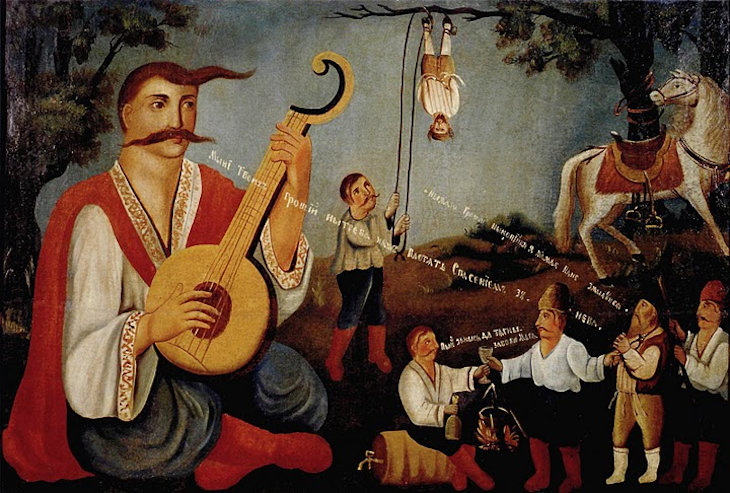 Cossack Mamay and the Haidamaka hang a Jewish usurer by his heels. Ukrainian folk art, 19th century
Cossack Mamay and the Haidamaka hang a Jewish usurer by his heels. Ukrainian folk art, 19th century
With many farms and businesses owned by absentee Polish landlords and nobles, an exploitative system called arenda developed, which allowed agents to manage farms and other enterprises on behalf of absent landlords. It was often Jews who were employed to manage the arenda economy, acting as caretakers for absentee nobles and landowners. Jews managed salt mines, farms, mills, and inns. They also became local tax collectors for Polish noblemen. Many arendas were in the alcohol trade: brewing, selling alcohol and managing inns and taverns were often seen as Jewish professions.
Working for hated landlords put Jews in an impossible position: they needed the arenda system in order to survive economically, but the local peasants blamed Jews for their employers’ increasingly abusive practices. When Polish nobles increased taxes on their already suffering tenants, it was their Jewish agents who bore the blame. In time, extreme antisemitism became engrained in much of Ukrainian culture.
A series of Cossack raids began in 1648, aimed at freeing Cossack communities from the domination of Polish landlords. The leader of these attacks was Bohdan Chmielnicki, who agitated for an independent Ukrainian country. Reflecting Cossack culture, Chmielnicki blamed Jews for his countrymen’s problems and encouraged his followers to massacre Jews.

Between 1648 and 1651, Chmielnicki’s followers killed about 20,000 Jews with unimaginable barbarity. Approximately half of all Jews living in Ukraine fled. So great was the Cossacks’’ depravity that some terrified Jews even fled into Crimea, where they faced slavery in the hands of Muslim Tatars.
The official records of the Jewish community in Kiev recorded the beginning of the massacres:
Immediately after the death of the pious King Wladyslaw (1648) tens of thousands of villains, among them Cossacks…went forth and committed manu murders in the holy communities of Niemirow, Tulczyn, Machnowka, and other hold communities who congregated in order to save their lives from the…sword… Since the destruction of the Temple no other cruel murder like this one was committed for the sanctification of the name” of God.
Another eyewitness account described “they massacred about 6,000 souls in the town…and they drowned several hundreds in the water and by all kinds of cruel torments. In the synagogue, before the Holy Ark, they slaughtered with butchers’ knives…after which they destroyed the synagogue and took out all the Torah books…they tore them up…and they laid them out…for men and animals to trample on…they also made sandals of them…and several other garments.” The Cossacks knew no bounds in their sadism and cruelty and attacked and killed Jews – as well as some Polish nobles – with horrific barbarity.
Chmielnicki appealed for military aid from Russia and in 1654 much of Cossack-controlled Ukraine became a client state of Russia. Sporadic pogroms continued through the years, most notably in the city of Uman in 1768.
In the 1780s and 1790s, Russia gained an enormous amount of territory, much of which was home to large Jewish communities at the time.
With the outbreak of the Russo-Turkish War in 1768, Russia began impinging on the Ottoman Empire’s semi-autonomous holdings in Crimea Russia annexed Crimea in 1783. (Crimea borders contemporary Ukraine and was part of Ukraine until 2014, when Russia annexed it once again). This large land acquisition coincided with an even greater gain in territory for the Russian empire. Russia’s Empress Catherine the Great oversaw three partitions of the Polish-Lithuanian Commonwealth, in 1772, 1793 and 1795. Within the span of a few years, Russia became home to the largest population of Jews anywhere in the world.
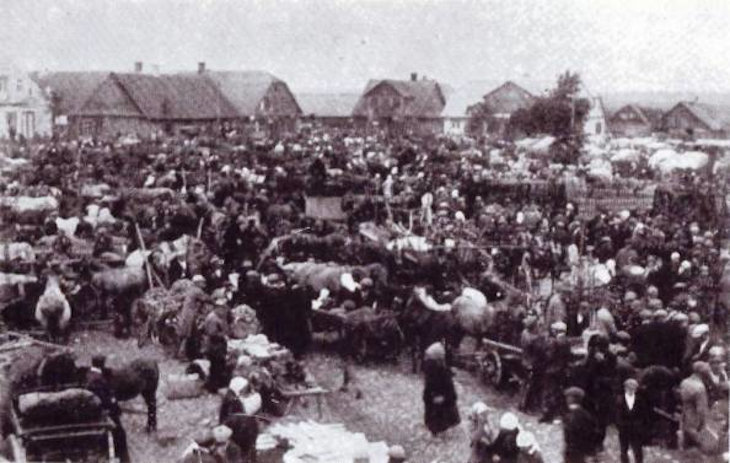
Jews had long been banned from living in most of Russia, and they remained unwelcome guests even when Poland and Lithuania came under Russian control. Catherine the Great confined Jews to newly acquired territories, with one notable exception: Jews were encouraged to move into Crimea in order to help settle sparsely inhabited territories there. The area where Jews were allowed to live was known as the Pale of Settlement: Cherta Osedlosti (“Boundary of Settlement”) in Russian and Der Techum Ha’Moyshev (‘Limits of Residence”) in Yiddish.
The exact boundaries of this area fluctuated through the years, but it included Russian-owned Poland, Lithuania, Belorussia (present day Belarus), Bessarabia, Crimea, and most of Ukraine. In time, the Jewish community in Ukraine would become one of the most spiritual, vibrant, and influential anywhere in the world.
The founder of Hasidic Judaism, the Baal Shem Tov (1700-1760) didn’t live in Ukraine; his home was a couple of miles outside the Ukrainian border, in Poland. But the friend and disciple who spread the ideas of Hasidic Judaism and developed it into a distinct religious movement did so within Ukraine, from his base in the city of Mezeritch.
Rabbi Dov Ber, also known as the Maggid (preacher) of Mezeritch (1704-1772), first consulted with the Baal Shem Tov when he was ill. The Baal Shem Tov was known as a healer, as well as a religious sage. Rabbi Dov Ber was so impressed that he adopted the Baal Shem Tov’s worldview, which emphasized worshiping God with joy. Within a generation, Ukraine was home to some of the most important and influential Hasidic masters, including Rabbi Levi Yitzchak of Berditchev and Menachem Nachum (and his son Modechai Twersky) of Chernobil. Ukrainian Jewish communities embraced Hasidic Judaism, with its emphasis on rigorously religious practice combined with spirituality and an emphasis on infusing religious observance with joy.
Perhaps the greatest Hasidic rabbi in Ukraine was Rabbi Nahman, from the Ukrainian town of Breslov (1772-1811), a great grandson of the Baal Shem Tov and a direct descendent of the Maharal, one of Europe’s greatest rabbis who lived in 16th century Prague. Rabbi Nahman built a large community in the Ukrainian town of Zlapotol in the early 1800s. He taught that Jews should strive to feel close to God at all times, and that feeling happy is best way to appreciate all of God’s many blessings.
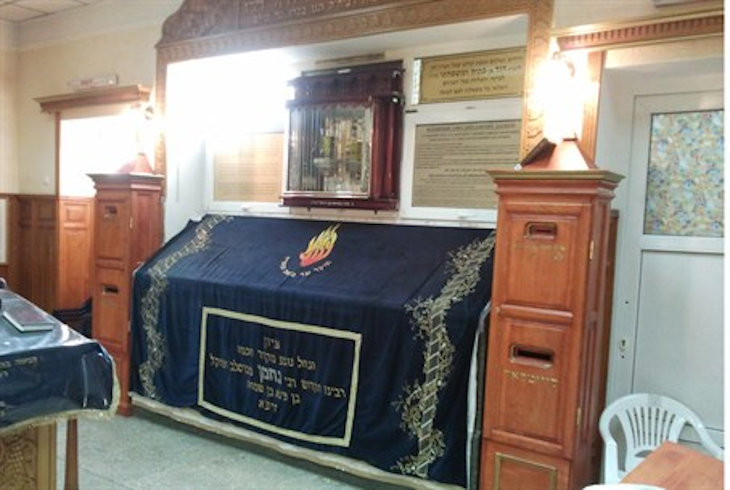 Rabbi Nahman’s gravesite in Uman
Rabbi Nahman’s gravesite in Uman
The Ukrainian town of Uman, about 125 miles south of Kiev, is where Rabbi Nachman of Breslov lived during his final years and is buried. Uman has emerged as a major pilgrimage site for thousands of Jews each year. The most popular time to go is Rosh Hashanah, when tens of thousands of Jews visit Uman to celebrate the holiday together in the place where Rabbi Nahman taught.
In 1881, Czar Alexander II was murdered by a left-wing terrorist. Soon, it was being (incorrectly) reported across Russia that the new Czar Alexander III had ordered Russian subjects to kill Jews. Pogroms broke out, with the greatest number taking place in Ukraine. These weren’t the first massacres of Jews in Ukraine and elsewhere in the Pale of Settlement, but the frequency and intensity of the mob attacks resulted in the phenomenon being given a new name: pogrom, which means violence in Russian.
Pogroms continued throughout the end of the 19th century. Some of the most horrible pogroms took place in 1905, after Czar Nicholas II issued the October Manifesto, guaranteeing all Russian subjects some basic political rights. The manifesto came at a perilous time in Russian politics, with political rivals ready to attack each other. As violence broke out, mobs turned on the Jews in their midst. Some of the worst anti-Jewish attacks were in the Ukrainian city of Odessa: the Jewish newspaper Voskhod reported that over 800 Jews were murdered in pogroms in Odessa in the days following the October Manifesto, and several thousands more were wounded.

Among the many towns engulfed in pogroms in 1905 was Kiev, Ukraine’s capital. There, the rampaging crowds attacked Jews for three days and nights. One of the terrified Jews during that ordeal was the well-known Yiddish writer known as Sholem Aleichem (his real name was Solomon Naumovich Rabinovich). For three days, he and his family hid in a hotel, listening to the terrible screams from their fellow Jews as they were attacked, maimed and killed outside.
Sholem Aleichem’s daughter later described the moment they realized their lives were in danger: “We ran from our beds to the windows on the street and looked down on the scene of brutality and murder – a gang of hoodlums beating a poor young Jew with heavy sticks; blood was running over the face of the young man, who was vainly shrieking for aid. A policeman stood nearby, casually looking on and not moving a finger.”
 Sholem Aleichem
Sholem Aleichem
After the Kiev pogrom, Sholem Aleichem’s entire family fled Ukraine, eventually settling in New York.
The Russian Revolution in 1917, the Polish Ukrainian War of 1918-1919, the Ukrainian War of Independence, and the Soviet-Polish War of 1919-1921 sparked waves of hundreds of pogroms across the region which killed approximately 100,000 Jews. (Ukraine was briefly independent, before being divided by Poland and Russia.) The violence was unspeakably intense. In the Ukrainian town of Proskurov, for instance, a three-day pogrom that broke out on February 15, 1919 killed 1,500 Jews. The town of Pogrebinschi experienced two pogroms: in May, 1919 Soviet troops went on a murderous rampage, killing 400 Jews. Three months later, Ukrainian nationalists staged a second pogrom and murdered a further 350 Jews there. Over 1,300 towns became scenes of horrific violence towards Jews.
As Ukraine was roiled by the wave of pogroms in 1881, a group of idealistic Jewish students realized that the only way Jews could ever live in safety was in their own land, in the Land of Israel. In 1882, they formed the first modern Zionist organization, BILU. The name was an acronym of the Biblical verse Beit Ya’akov Lechu V’nalcha – “The House of Jacob, come let us go'' (Isaiah 2:5).
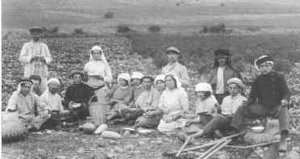
BILU managed to raise money to send 14 university students to the Jewish town of Rishon Le-Zion, where they farmed. The Ukrainian Jews had a very difficult time. They lacked farming skills and faced continual violence from Arab raiders. Yet their experiment in farming in the Land of Israel showed other Jews in Europe that it could be done.
Before the Holocaust, Ukraine had the largest Jewish population of any European country. For the first year of World War II, Ukrainian Jews were relatively protected by the non-aggression pact that Hitler and Stalin signed, guaranteeing that Nazi troops wouldn’t invade Russia’s vast territories. That changed on June 22, 1941, when Germany launched Operation Barbarossa, and invaded the Soviet Union. In the ensuing years, special Nazi troops called Einsatzgruppen entered towns in Ukraine and elsewhere in eastern Europe, rounding up all Jews, forcing them to dig large mass graves, then shooting them.
The largest Nazi massacre in Ukraine – and one of the largest single massacres in the entire Holocaust – took place near Ukraine’s capital Kiev on September 28, 1941, in Babi Yar. On that morning, all Jews were ordered to assemble in the center of the city. Under Nazi guard – and in full view of the populace – they were marched out of the city to a large natural ravine on the outskirts of Kiev called Babi Yar. The ostensible “reason” given for this wholesale massacre of Jewish women, children and old men (most young men were away fighting) was a Soviet attack on military headquarters in Kiev.
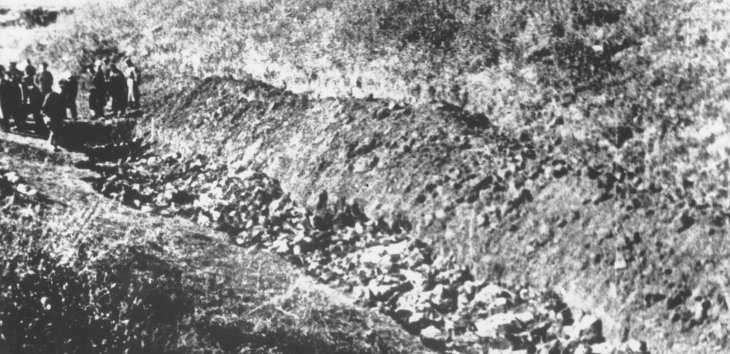
The Nazi Einsatzgruppe C unit which carried out the killing kept meticulous records of the day:
The bitter hostility of the Ukrainian population against the Jews is extremely great… All Jews were arrested in retaliation for the arson in Kiev, and altogether 33,771 Jews were executed on September 29th and 30th. Gold, valuables and clothing were collected and…given to the appointed city administration for distribution to the needy population.
33,771 Jews were shot over two days and their bodies thrown into the Babi Yar ravine. Over the following two years, more than 60,000 more people were murdered at Babi Yar. In addition to Jews, Soviet POWs, Roma and psychiatric patients from a nearby hospital were also killed. It’s estimated that of the approximately 100,000 people were murdered at Babi Yar, 60,000 of them were Jews.
Following the Holocaust, Ukrainian Jews faced hostility and violence from their neighbors when they returned home. The crimes of the Holocaust were covered up; Babi Yar was largely filled in and only received a memorial 1976. It did not specify that Jews were the primary victims who died there.
When Ukrainian President Volodymyr Zelensky was elected in 2019, he wasn’t a politician – though he’d played one on TV.
 President Zelensky at the Western Wall
President Zelensky at the Western Wall
Zelensky, who was just 41 when he became Ukraine’s president, shot to fame in Ukraine when he appeared on a hit television show there called Servant of the People, in which he played an honest president. His fellow countrymen were sick of corruption, and elected the Jewish actor with a landslide 73% of the vote.
President Zelensky is Jewish (as is Ukraine’s former Prime Minister, Volodymyr Groysman). As he faces 100,000 Russian troops amassed at his borders, President Zelensky is hoping to fend off a Russian invasion, and has appealed to the example of the Jewish state, which vigorously defends itself from external enemies: “Both Ukrainians and Jews value freedom, and they work equally for the future of our states to become to our liking, and not the future which others want for us. Israel is often an example for Ukraine.”
